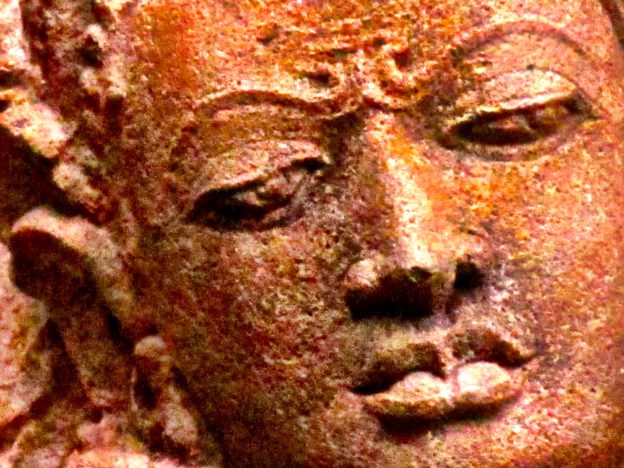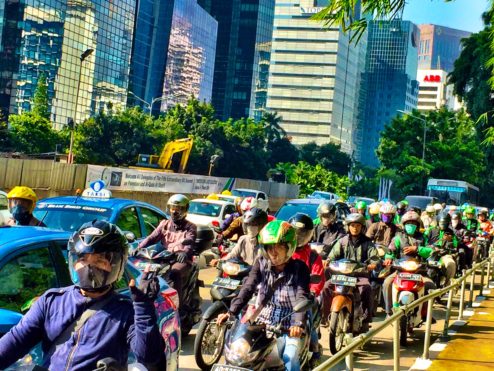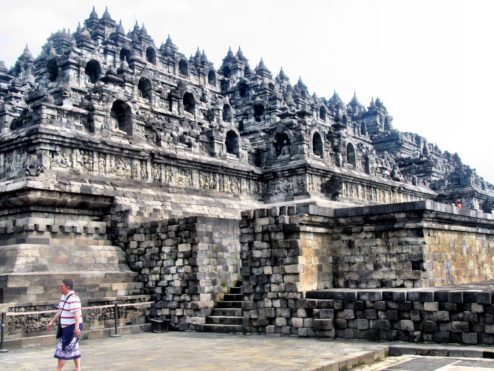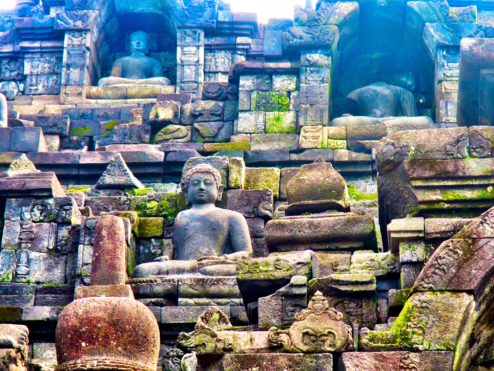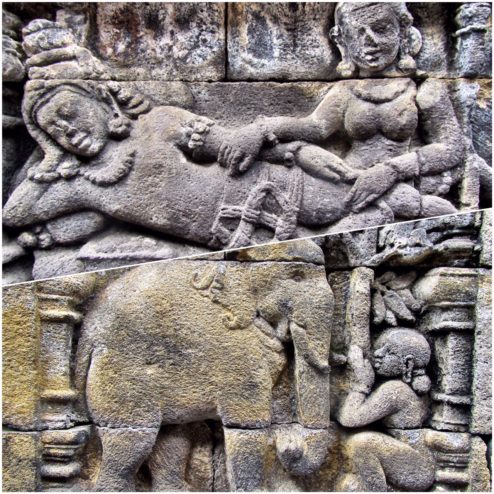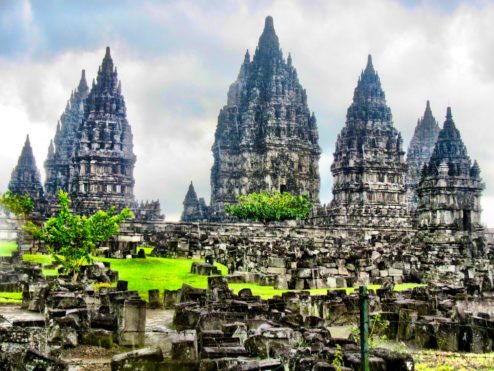The final leg of my very hot and humid two-month Asian travel was a well planned and luxurious cultural tour, “Java & Bali: Indonesia’s Mystical Islands”, with Overseas Adventure Travel (OAT). A separate blog on Bali will follow. As usual with OAT, the tour was extremely comfortable with amazing meals and accommodations and a thoughtful and generous guide, Manik, educating and herding me and the delightful 10 ladies and 3 gentlemen on our tour.
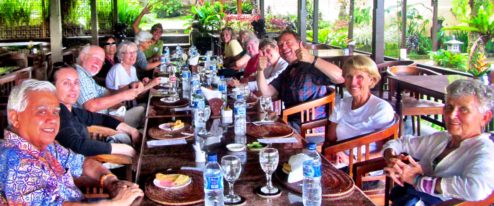 Java, an Indonesian island, is the most populous island on Earth with over 150 million residents; it is also the most populous Muslim majority country in the world encouraging both conservative and modernist religious practices. Indonesia, situated in Southeast Asia, between the Indian and Pacific Oceans, is the largest island country and contains the most volcanoes in the world. With more than thirteen thousand islands and a total population of over 260 million people, it is the world’s fourth most populous country! The Indonesian Constitution recognizes 6 religions: Islam, Catholicism, Protestantism, Buddhism, Hinduism, and Confucianism. Today, compared to most places in the world – it’s a harmonious melting pot of diverse communities, religions and cultures. Furthermore, I can honestly say that the locals that I met here in Indonesia were the nicest people I have ever met.
Java, an Indonesian island, is the most populous island on Earth with over 150 million residents; it is also the most populous Muslim majority country in the world encouraging both conservative and modernist religious practices. Indonesia, situated in Southeast Asia, between the Indian and Pacific Oceans, is the largest island country and contains the most volcanoes in the world. With more than thirteen thousand islands and a total population of over 260 million people, it is the world’s fourth most populous country! The Indonesian Constitution recognizes 6 religions: Islam, Catholicism, Protestantism, Buddhism, Hinduism, and Confucianism. Today, compared to most places in the world – it’s a harmonious melting pot of diverse communities, religions and cultures. Furthermore, I can honestly say that the locals that I met here in Indonesia were the nicest people I have ever met.
 Our OAT tour first started in Jakarta, the country’s capital, located on the northwest coast of Java; it is the country’s financial, political, and industrial center.
Our OAT tour first started in Jakarta, the country’s capital, located on the northwest coast of Java; it is the country’s financial, political, and industrial center.
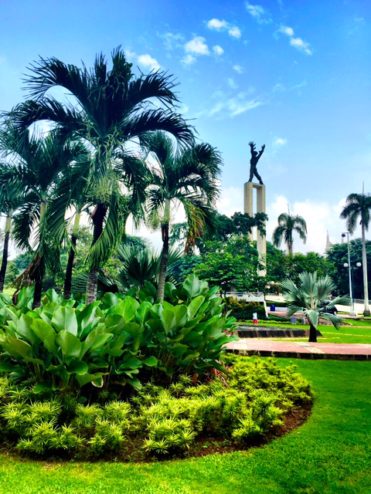 As this was a return trip for me, I ditched my tour group to explore neighborhoods with solo fast-walking. Heavy traffic with loud honking cars, fleets of motorcycles weaving through traffic like a tapestry with no pattern, and a multitude of suicidal yet calm jaywalkers are daunting to North American pedestrians. Because of this wonderfully unrehearsed dance of man and machines, it appeared impossible to cross any road, side street and even alleyway – without first telling your family you love them. However, without many traffic lights, I joined the Jakartan way of life, and dashed and dodged with the best of them.
As this was a return trip for me, I ditched my tour group to explore neighborhoods with solo fast-walking. Heavy traffic with loud honking cars, fleets of motorcycles weaving through traffic like a tapestry with no pattern, and a multitude of suicidal yet calm jaywalkers are daunting to North American pedestrians. Because of this wonderfully unrehearsed dance of man and machines, it appeared impossible to cross any road, side street and even alleyway – without first telling your family you love them. However, without many traffic lights, I joined the Jakartan way of life, and dashed and dodged with the best of them.
The key is The Hand. Don’t underestimate The Hand, it has the power of Moses parting the Red Sea. I raised out The Hand to the oncoming traffic, puffed up my chest and just started walking. Somehow, these cars of all sizes and motorcycles miraculously deftly swerved around me. Jaywalking, I admit, took guts and skill, but most of all, The Hand. Without it, motorists will just assume you have a death wish, instead of the drivers’ interpretation of the gesture as a polite way of saying “Excuse me, Kind Sir, I would greatly appreciate it if you didn’t smush me.”
Next, we flew an hour east in Java to Yogyakarta (pronounced ‘Jog-jakarta’ and called ‘Jog-ja’ for short). It is renowned as a center of education including a world-class university; and classical Javanese fine art and culture such as batik, dance, drama, music, poetry and puppet shows. Visiting important archaeological sites like Borobudur, Prambanan, and Sambisari Temples presents an overwhelming amount of sculpture and masonry to teach the history and its ways of life of the area. We also walked 12km around the active Mount Merapi, visited the local arts and crafts producing neighborhoods, met with a number of kind Indonesian veterans, and dutifully shopped like good Americans at a gorgeous batik production site.
Borobudur (above & below) and Prambanan, are 9th-century Buddhist and Hindu temples, respectively, and UNESCO World Cultural Heritage Centers. Both were built some 300 years before Angkor Wat in Cambodia. Also, the close proximity of the two temples tells me that on Java, Buddhism and Hinduism lived peacefully together, or felt no need to destroy the other religious icons when one became more dominant.
The magnificent Borobudur temple is the world’s biggest Buddhist monument, an ancient site widely considered to be one of the world’s seven wonders. It is built from over two million stone blocks in the form of a massive symmetrical stupa, literally wrapped around a small hill. The nine-level monument is massive; imagine an 11-story building on less than 3 square city blocks. The six layers at the bottom, represent the everyday world; the top three layers represent enlightenment. At the base layer, there were series of bas-reliefs representing the world dominated by passion and desire, where the good are rewarded by reincarnation as higher forms of life as you ascend, while the evil are punished with a lower life form reincarnation. There were richly decorated narrative panels (below) carving out a virtual textbook of Buddhist doctrines as well as many aspects of Javanese life 1000 years ago. Plus some 500+ serene-faced Buddha images staring out from open chambers, as well as inside many latticed stupas on the top three tiers. Once a year, Borobudur is used for pilgrimage; and today, Borobudur is Indonesia’s single most visited tourist attraction.
At the apex, we watched smoke emerging from the nearby Mount Merapi, the most active volcano in Indonesia that erupted in 2014.
As the largest Hindu temple complex (above) in Southeast Asia, the beautiful and graceful temple of Prambanan is a magnificent spectacle. The height of a 14-story building, the highest Hindu temple in the world is dedicated to Shiva – the destroyer, and the two smaller ones are dedicated to Brahma – the creator, and Wisnhu – the sustainer. More temples nearby are dedicated to the animals (below) who served them. This temple complex is surrounded by some 200 ‘Guardian Towers’ all crumbled except two, recently restored.

